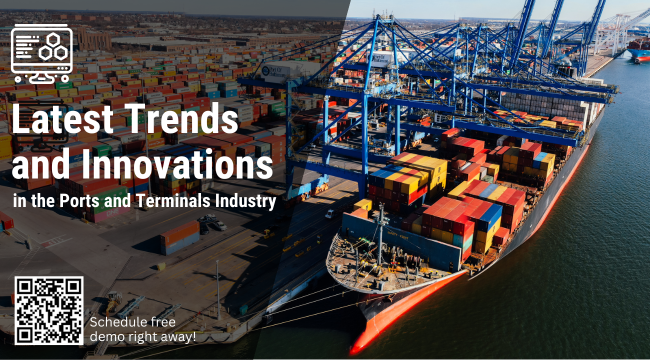
The ports and terminals industry is a vital component of global trade, serving as the entry and exit points for goods and commodities. As international trade continues to grow, the industry is evolving to meet the challenges of larger ships, increased volumes, and the need for more efficient operations. In this blog, we will explore some of the trending topics in the ports and terminals industry, highlighting innovations and strategies that are shaping its future of how port operations are set to evolve on the digital front.
Automation and Digitalization
Automation and digitalization are transforming the way ports and terminals operate. The use of technologies such as automated stacking cranes, automated guided vehicles, and real-time monitoring systems is improving efficiency and reducing costs. For example, the use of automated stacking cranes can increase container handling rates by up to 50% compared to traditional methods. Additionally, digital platforms are being developed to streamline communication and data exchange between stakeholders in the supply chain, enhancing the overall efficiency of port operations.
Private Wireless Networks
Private wireless networks are another trend gaining traction in the ports and terminals industry. These networks provide secure, reliable, and high-speed connectivity for critical operations such as cargo handling and vessel management. Nokia, a leading provider of private wireless solutions, has successfully deployed such networks at several ports worldwide, enhancing safety, efficiency, and productivity.
Sustainability and Environmental Concerns
As the industry continues to grow, sustainability and environmental concerns are becoming increasingly important. Ports and terminals are under pressure to reduce their environmental impact, and innovations such as green ports, solar-powered terminals, and eco-friendly equipment are emerging as solutions. For instance, PSA International, one of the world’s largest port operators, has set ambitious sustainability targets, including a goal to reduce its carbon footprint by 50% by 2030.
Investment and Infrastructure Development
Investment in port infrastructure is another key trend driving growth in the industry. Governments and private companies are investing heavily in upgrading and expanding port facilities to accommodate larger ships and increasing volumes. For example, the United States is investing USD 150 billion in its seaports, which is expected to generate 1.6 million jobs. Similarly, COSCO-PSA Terminal is investing in Singapore Port to increase berthing capacity and cater to next-generation mega-size container ships.
Challenges and Opportunities
Despite these trends and innovations, the ports and terminals industry still faces significant challenges. Managing congestion risk, for instance, is a major concern, as it can lead to delays, increased costs, and disruptions to the supply chain. However, these challenges also present opportunities for innovation and collaboration. For example, the use of data analytics and real-time monitoring can help optimize port operations and reduce congestion.
Conclusion
The ports and terminals industry is undergoing significant transformations driven by technological advancements, sustainability concerns, and investment in infrastructure. As the industry continues to evolve, it is crucial for stakeholders to stay informed about the latest trends and innovations.
At LogStar, we have embraced automation, digitalization, and sustainability, all of these delivered through our SaaS solutions crafted and customized for the ports and terminals industry. Our solutions ensure efficient, safe, and environmentally friendly operations that support the growth of global trade and digitalization initiatives.
Follow us for latest update on trends and technology in Ports and Terminals industry.
Hurry! We are offering free product demos till June 2024, register right away!
